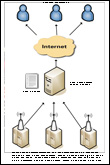RadioActivity: Articles
Calculating 'Aggregate Tuning Hours'
Part 4: Complicating factors
The basic methodology for calculating ATH, then, is to use the data in these logfiles and sum up total listening time.There are, of course, a few complicating factors:
Factor #1: Shared streaming hosts
Factor #2: Using proper date ranges
Most streaming servers can easily handle many broadcasters at once, but the connections all end up in a single logfile. Extra steps must be taken to ensure the logfiles used to calculate ATH are representative only of that station's streaming. If the streaming server delivers a mix of live and archived content, this also becomes an issue, as both must factor into the overall ATH calculation.
( In the same vein - if a station is streaming in several different formats, or providing multiple bitrate streams, these all need to be taken into account when calculating ATH. Logfiles may have to be tallied individually and then added together, or combined, to reflect all the available stream listeners. )
The solution? The easiest solution is to examine logfiles and remove any known entries for mountpoints or media that do not belong to the reporting entity. Common text parsing tools can help, as can a simple text editor. The solution RadioActivity.fm employs in its ATH calculation tool is to list all of the mountpoints that were used to calculate the ATH. If a mountpoint or media is listed that does not belong to the reporting station, the station can remove those entries from their logfiles and run the ATH calculation again.
Factor #3: Bots/0-second connectionsStreaming media servers can run for months, even years, without rebooting, and because of this their logfiles often represent long streteches of time. Stations only have to report two 7-day spans, however, so the ATH calculation process is less intensive if station's don't analyze the whole logfile, and instead only analyze the two 7-day spans.
The solution? The easiest way to address this problem is to open the logfiles in a text editor and remove any unneeded dates. As most logfiles are sequential by date, it is trivial to 'trim' the logs to represent only the date spans being reported. The RadioActivity ATH calculation tools calculate ATH by each day represented in the logfiles, allowing stations to further 'weed out' specific dates if more are being analyzed than are needed.
Factor #4: Local/Private IP blocksThere are a number of media search-engine services that make connections to streaming servers as part of their indexing activity - these are commonly referred to as 'bots'. In the sample logfiles, you will see connections from 'sproose bot' that last for 0 seconds. These connections are from computers - not human listeners - and should not be factored into the ATH calculations.
The solution? The easiest solution is to discard any known bots and 0-second connection entries. With audio indexing services on the rise that actually download and index human speech, however, a running list of known downloading bots will soon have to be compiled and maintained in order to remove their entries from logfiles as well.
Factor #5: Non US-listenersSome logfiles may contain entries from non-routable IP addresses. Reasons for this vary according to network configuration, but these usually represent non-listener 'chatter' from machines in the local environment. These IP addresses are usually of the form 10.*.*.*, 172.*.*.*, 192.168.*.*, and should not be factored into the ATH calculations. Stations that use automated systems to listen and/or archive their stream may also fall into this category.
The solution? The easiest solution is to discard any known private IP blocks. Stations using archive/automated stream listening devices should remove these entries by hand before analyzing their logs.
The Copyright Royalty Board's definition of ATH specifies to all listeners within the United States. Thus, if logfiles contain entries from non-U.S. listeners, they should not be included in the ATH calculation.The solution? The RadioActivity.fm ATH calculation tool uses a commercial geolocation database to determine the country of origin for connecting listeners, and gives stations the option of discarding known non-U.S. stream connections. U.S. and international ATH are also calculated separately in the RadioActivity.fm ATH calculation tool.
With these issues in mind, RadioActivity.fm built online streaming server parsing tools that calculate ATH.
Click here to read Part 5, Putting It All Together|
Part 1: Introduction Part 2: What is ATH? Part 3: Streaming server logs Part 4: Part 5: Putting it all together - our online tools |
